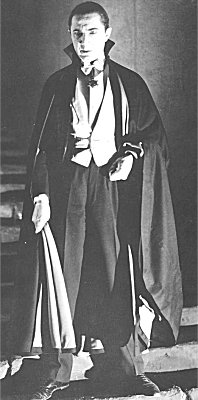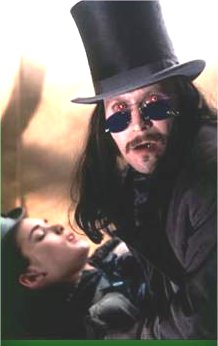 Real
Name: Vlad Tepes
Real
Name: Vlad Tepes
Dracula
 Real
Name: Vlad Tepes
Real
Name: Vlad Tepes
Identity/Class: Vampire
Occupation: Count
Affiliations:His three brides
Enemies: Professor Abraham van Helsing, Johnathan Harker, Quincey Morris, Dr.Jack Seward, Lord Arthur Holmwood
Known Relatives: Vlad (father, deceased); Radu (brother, deceased)
Aliases: Vlad the Impaler; Vlad Dracula; Vlad Dracul
Base of Operations: Originally Transylvania; briefly England
First Appearance: Dracula
Powers/Abilities: Dracula isn't a vampire, he's THE vampire. He is able to turn into a wolf, a bat, rats, and mist. He controls the weather, particularly storms, he can walk down the side of walls, and he can command the vermin of the Earth. He has supernatural strength and can move so fast that mortal eyes can't even see him. Unlike many vampires, he can easily walk around in daytime, although it weakens him.
History: (Historically speaking): Vlad "the Impaler" is believed to have been born around 1431. His father, also called Vlad, was a military commander with responsibility for guarding the mountain passes from Transylvania into Wallachia from enemy incursion. In that year the senior Vlad was summoned to Nuremberg by Sigismund, the Holy Roman Emperor, to receive a unique honor. He was one of a number of princes and vassals initiated by the Emperor into the Order of the Dragon, an institution, similar to other chivalric orders of the time, modelled on the Order of St George. Created in 1408 by Sigismund and his queen, it required its initiates to defend Christianity and to do battle against its enemies, principally the Turks. As an indication of his pride in the Order, Vlad took on the nickname "Dracul." (The Wallachian word "dracul" was derived from the Latin "draco" meaning "the dragon.") The sobriquet adopted by the younger Vlad was "Dracula", which meant "son of Dracul" or "son of the Dragon".
 Vlad was the
second of three sons; his brothers were Mircea and Radu. While he was a child,
the Holy Roman Emperor Sigismund died, and the senior Vlad worked on policies
of neutrality with the Turks, feeling it was necessary to do this to protect
the interests of Wallachia. The Sultan felt he needed something to ensure
Dracul's support, and so demanded Vlad and Radu as hostages, guaranteeing
good behaviour. Vlad, probably around eleven at the time, may have spent
up to six years under this precarious arrangement. The younger brother Radu,
a handsome lad who attracted the attention of the future sultan, fared better
than Vlad, a factor that helps explain the bitter hatred and rivalry that
developed between the brothers later. Apparently, no serious physical harm
came to the boys during these years of captivity, though the psychological
impact on Vlad is difficult to assess. They were released in 1448, but Radu
remained in Turkey.
Vlad was the
second of three sons; his brothers were Mircea and Radu. While he was a child,
the Holy Roman Emperor Sigismund died, and the senior Vlad worked on policies
of neutrality with the Turks, feeling it was necessary to do this to protect
the interests of Wallachia. The Sultan felt he needed something to ensure
Dracul's support, and so demanded Vlad and Radu as hostages, guaranteeing
good behaviour. Vlad, probably around eleven at the time, may have spent
up to six years under this precarious arrangement. The younger brother Radu,
a handsome lad who attracted the attention of the future sultan, fared better
than Vlad, a factor that helps explain the bitter hatred and rivalry that
developed between the brothers later. Apparently, no serious physical harm
came to the boys during these years of captivity, though the psychological
impact on Vlad is difficult to assess. They were released in 1448, but Radu
remained in Turkey.
Vlad returned hom to find his father had been assassinated and his older brother buried alive by the nobles of Târgoviste who had supported a rival claimant. Vlad seized power, and according to an early Romanian chronicle, in the spring of 1457, he invited the nobles responsible for the deaths of his father and brother, along with their families, to an Easter feast. After his guests had finished their meal, Vlad's soldiers surrounded them, rounded up the able-bodied and marched them fifty miles up the Arges River to Poenari, where they were forced to build his mountain fortress. His prisoners laboured under very difficult conditions for many months. Those who survived the gruelling ordeal were impaled. But this reign was short-lived, and Vlad spent the next eight years plotting his return to power. Finally in 1456 he was successful and ruled for the next six years.
 Having regained
his throne in 1456, he set about consolidating his power base, something
he went about with ruthless efficiency. As well as dealing with internal
problems, he faced the threat of the Turks, who had conquered Constantinople
only three years earlier. Raiding and pillaging occurred along the Danube
border, and then full-fledged war broke out during the winter of 1461-62.
Outnumbered by the Turks, Vlad used every means at his disposal to fight
back - as he retreated, he would burn the villages he was leaving and poison
the wells, he fought hit and run battles. He even sent victims of infectious
diseases into the enemy camps, an early form of germ warfare. And he used
psychological warfare - according to one account on the outskirts of his
capital the Turk army was met with the site of a field of stakes, three
kilometres long and one wide, with men, women and children impaled on them,
twenty thousand strong. Faced with an enemy prepared to do this, the Sultan
withdrew his forces.
Having regained
his throne in 1456, he set about consolidating his power base, something
he went about with ruthless efficiency. As well as dealing with internal
problems, he faced the threat of the Turks, who had conquered Constantinople
only three years earlier. Raiding and pillaging occurred along the Danube
border, and then full-fledged war broke out during the winter of 1461-62.
Outnumbered by the Turks, Vlad used every means at his disposal to fight
back - as he retreated, he would burn the villages he was leaving and poison
the wells, he fought hit and run battles. He even sent victims of infectious
diseases into the enemy camps, an early form of germ warfare. And he used
psychological warfare - according to one account on the outskirts of his
capital the Turk army was met with the site of a field of stakes, three
kilometres long and one wide, with men, women and children impaled on them,
twenty thousand strong. Faced with an enemy prepared to do this, the Sultan
withdrew his forces.
But the conflict was not over; instead the Sultan tried to use internal strife to topple Dracula. He supported Radu who led a force of defecting boyars and Turkish soldiers in pursuing Vlad all the way to his mountain fortress at Poenari. In 1462 he escaped into Transylvania, but was arrested near Brasov by Matthias Corvinus, the king of Hungary, who had chosen to throw his support behind Radu, Vlad's successor. Corvinus held him captive until the mid-1470's, when they appear to have struck a deal, with Corvinus offering to help him return to power, in return for Vlad marrying a relative of his.
His recovery of the throne for a third time in 1476 was brief, for he was killed in battle during the subsequent winter.Less than two months into his final reign (probably near the end of December, 1476) Vlad was killed in battle in a forest just north of Bucharest. The circumstances of how he died are unclear, though many stories suggest possible ends for him. Equally we do not know where his final resting place is.
 (Fictional)
In the 1890's a Transylvanian nobleman who called himself Count Dracula made
arrangements with a London law firm to purchase property in and around
London. The young lawyer sent to help expedite the paperwork, one Johnathan
Harker, soon discovered that Dracula was a fiend from Hell, a vampire who
imprisoned him before travelling to England where he preyed upon a couple
of English ladies, one of whom was Harker's fiancee, Mina Murray. Harker
escaped captivity and made his way home, and together with the help of Dr
Abraham van Helsing and the suitors of the other victim of Dracula, they
destroyed his London haunts and forced him to flee back to his homeland.
The hunters chased Dracula down, and back at his castle, they destroyed him.
(Fictional)
In the 1890's a Transylvanian nobleman who called himself Count Dracula made
arrangements with a London law firm to purchase property in and around
London. The young lawyer sent to help expedite the paperwork, one Johnathan
Harker, soon discovered that Dracula was a fiend from Hell, a vampire who
imprisoned him before travelling to England where he preyed upon a couple
of English ladies, one of whom was Harker's fiancee, Mina Murray. Harker
escaped captivity and made his way home, and together with the help of Dr
Abraham van Helsing and the suitors of the other victim of Dracula, they
destroyed his London haunts and forced him to flee back to his homeland.
The hunters chased Dracula down, and back at his castle, they destroyed him.
Comments: In Romanian history, Vlad is usually referred to as "Tepes" (pronounced Tse-pesh). This name, from the Turkish nickname "kaziklu bey" ("impaling prince"), was used by Ottoman chroniclers of the late fifteenth and early sixteenth centuries because of Vlad's fondness for impalement as a means of execution. The epithet, which echoed the fear that he instilled in his enemies, was embraced in his native country. No evidence exists to suggest that Vlad ever used it in reference to himself. By contrast, the term "Dracula" (or linguistic variations thereof) was used on a number of occasions by Vlad himself in letters and documents that still survive in Romanian museums.
The vampiric version of Dracula was created by Bram Stoker.
Mack Lambert rightly notes that, in the novel "Contrary to popular belief, Count Dracula was not killed by a stake in the heart, a cliche commonly affiliated with vampirism. He was killed by a Bowie Knife."
CLARIFICATIONS: None
Any Additions/Corrections? Please let me know.
All images and characters depicted on this site are copyright their respective holders, and are used for informational purposes only. No infringement is intended and copyrights remain at source.